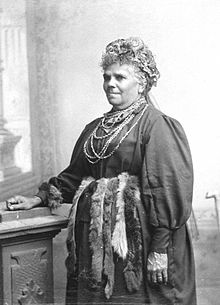Tasmanian languages

The Tasmanian languages were the languages of the indigenous people of Tasmania . These were systematically exterminated in the 19th century by the English colonizers within 80 years, and the Tasmanian languages were also extinct.
The last female speaker of a Tasmanian language was Fanny Cochrane Smith . There are also two wax cylinders with Tasmanian songs from her . They are the only native language documents of the Tasmanian language and music.
The Tasmanian language group and their relationships
It is believed that around 5,000 Tasmanians spoke around ten different languages at the beginning of the 19th century . The records on these languages are extremely poor and flawed. They are collected by Plomley in 1976, half of the material comes from George August Robinson and was recorded from 1829–34, but was not rediscovered until the 1950s. Almost all of the recordings (seafarers, settlers, material from the concentration camps) consist of simple short lists of words that were recorded by ear without any linguistic competence.
Because of the scarcity of the material, it is not even clear whether the Tasmanian languages were genetically related to one another and formed a single language family or multiple language families .
The external relationships of the Tasmanian languages have not been clarified either (and probably cannot be clarified either). Tasmania was settled from the north at least 35,000 years ago via the then existing mainland connection to Australia. The flooding of the Bass Strait by rising sea levels at the end of the last Ice Age about 12,000 years ago isolated the Tasmanians from the inhabitants of the Australian continent, so that cultural and technical innovations could no longer be exchanged. Still, it is likely that the Tasmanian languages are distantly related to the Australian languages , although common roots of words could hardly be identified. Crowley-Dixon expressed it in 1981 as follows: "All we can say, is thatthere is no evidence did Tasmanian languages were not related to languages spoken on the mainland" ( "All we can say is that there is no evidence indicates that the Tasmanian languages were not related to the languages spoken on mainland [Australian] ”).
According to Joseph Greenberg , the Tasmanian languages are not related to the Australian, but to the geographically distant Papuan languages and the Andaman languages . This so-called Indo-Pacific hypothesis of Greenberg is generally rejected.
Individual languages
Given the scarcity of the material, the identification of individual languages is of course very problematic. Crowley-Dixon 1981 come to at least six, maximum eight individual languages, which are defined by their geographical location. Original names have never been preserved.
- Central Tasmanian † Dialects: Oyster Bay, Big River, Little Swanport
- Southeast Tasmanian †
- Northeast Tasmanian † Dialects: Piper River, Cape Portland, Ben Lomond; North
- North Midlands Tasmanian †
- Port Sorell-Tasmanian †
- Northwest Tasmanian † Dialects: Northwest Coast, Robbins Island, Circular Head
- Southwest Tasmanian † ( uncertain )
- Macqarie Harbor Tasmanian † ( uncertain )
Linguistic characteristics
Given the scarcity of the available material, which has already been mentioned several times, it is extremely difficult to make substantive statements about the properties of the Tasmanian languages. The following remarks are based on Crowley-Dixon 1981.
The phonological system appears to the Australian languages have compensated: there were at least four plosive -series ( bilabial , apico-alveolar , Laminal and dorso-velar ), a lateral , two r-sounds and two semi-vowels . All plosives can be nasalized . Words usually consist of two syllables, consonant accumulation is common in the interior of a word, and rare at the beginning of a word.
The morphology was suffixing , but it is hardly possible to understand the functions of isolable suffixes . Hardly any statements can be made about syntactic functions and their marking (labeling) as well as about the basic word order in the sentence. (The few sentences that have been recorded seem to suggest SVO .) The adjective follows its noun .
Two pronouns can be identified. In Southeast Tasmanian they are mina “I” and nina “you”, in the other languages the corresponding forms are often very different, but the / m / - / n / opposition is retained.
Attempt to reconstruct Palawa Kani
Despite the extremely small number of extant sources, some Tasmanians are now trying to reconstruct their lost languages. The result is a composite language called Palawa Kani , which was constructed on the basis of the word lists obtained. Linguistically this is extremely questionable, as the word lists come from six to eight different languages, of which one does not even know whether they are genetically related. In practice it is a new artificial language. The scientific guidelines for this project have not yet been published. In general, it should be noted that a serious reconstruction of an extinct language on such an extremely poor basis - as described in all scientific articles on Tasmanian languages - is impossible. If there is talk of using the reconstructed artificial language in schools or in speeches, it is more a question of folkloric actions to strengthen a Tasmanian identity than a linguistically based reconstruction of language.
literature
- Terry Crowley and RMW Dixon: Tasmanian. In: RMW Dixon and Barry J. Blake (Eds.): Handbook of Australian Languages. Volume II. John Benjamin, Amsterdam 1981.
- Terry Crowley: Tasmanian Aboriginal Language: Old and New Identities. In: Michael Walsh and Colin Yallop (Eds.): Language and Culture in Aboriginal Australia. Aboriginal Studies Press, Canberra 1993.
- NJB Plomley: A Word-List of the Tasmanian Aboriginal Languages. Self-published, Launceston 1976.
- John Lynch: Pacific Languages. An Introduction. University of Hawai'i Press, Honolulu 1998.
- Wilhelm Schmidt: The Tasmanian languages. Sources, groupings, grammar, dictionaries. Spectrum, Utrecht, 1952.
